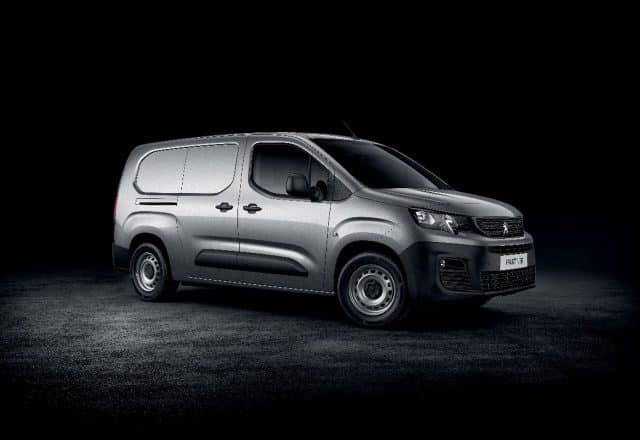Pros:
- Efficient engines
- Lots of space
- Lots of technology including overload indicator
Cons:
- Restricted equipment on entry models
- Scratchy surfaces in the cabin
The Peugeot Partner is still one of the best small vans available today and shares its underpinnings with the Vauxhall Combo and the Citroen Berlingo – plus the Toyota Proace. It’s still winning awards and there’s an impressive all-wheel drive version available. For the money, the standard Partner offers a well-made and robust van for everyday use. Don’t forget too, there’s the excellent all-electric Peugeot e-Partner to consider.
In the UK’s small van market, competition is stiff so why does the Peugeot Partner stand out? Firstly, it has been well-priced and offers to meet the needs of just about every business and private use. There’s the potential of a 1,000kg payload and it’s a cheap to run offering with robust diesel engines. It’s also very similar to the Citroen Berlingo so it may be that you choose the Partner on price and having a dealer nearby, but it’s worth the effort to road test one and check out the decent road manners.
PEUGEOT SAYS
This third-generation Partner van bears all the hallmarks of the first two generations and brings increased loading capacities, improved dynamics, Peugeot i-Cockpit and greater levels of driver assistance systems.
The Partner introduced new-to-segment technology, including a new Overload Indicator, informing the driver when the maximum authorised mass is exceeded, and Surround Rear Vision which enhances the driver’s rear-view visibility, feeding back footage from two cameras to display on a 5-inch colour screen that replaces the traditional rear-view mirror.
It also features Flankguard – a system informing the driver of the proximity of objects to the side of the manoeuvering vehicle, and an Automatic Electronic Parking Brake (included with the multi-flex passenger seat and available as an option in vehicles with a single passenger seat).
David Peel, the managing director of Peugeot UK, said: “The Partner van brings innovative technologies and increased load capacities to this highly competitive segment. It also benefits from many key USPs and driving aids, distinguishing it from the competition. It marks the renewal of a best-seller and looks to continue the success story of Partner LCV.”
Reasons to buy
Among the reasons to buy the Peugeot Partner is the attractive styling and to enjoy the spacious dimensions. While this is a small van, there’s plenty of storage space in the cab and there is an impressive load space with easy access. However, we really like the Peugeot i-Cockpit which helps set it apart from its Vauxhall and Citroen (and also Toyota) siblings. Most buyers will be looking at the price tag, but the low running costs and reliability means the Peugeot Partner van could be a sound investment for a business – especially since the battery-powered e-Partner is a pricey alternative still.
If you like the Peugeot Partner, then consider the Ford Transit Connect or the Volkswagen Caddy.
Running Costs
The running costs of the Peugeot Partner are impressive and one of the big changes since it first appeared in early 2019, is a move to more efficient diesel engines.
Now, the Partner has 1.5-litre diesel units that meet Euro 6.2 emission standards with power outputs of either 76 hp, or 102 hp.
There’s an alternative of a 1.2-litre PureTech petrol engine producing 110 hp but owners may find that when fully laden, the engine really does need to be worked hard at speed. However, this unit is probably the best choice for those who are undertaking short journeys around town.
Regardless, the Peugeot Partner has enough grunt to be a good performer in urban areas with fuel consumption ranging from 44 mpg to 56 mpg. Emissions are 147g/km.
Peugeot says that the Partner’s total cost of ownership will meet the needs of professionals since the van is durable and it is well-made.
Everything from the powertrains and equipment has been selected to deliver decent fuel economy and low routine maintenance costs.
Service intervals for the Peugeot Partner are every two years or 25,000 miles for the 1.5-litre BlueHDi diesel engines. There’s also a 100,000 mile, or three-year warranty included.
Load Space
For a small van, the Peugeot Partner appears to be more spacious than it really is.
It’s available in four trim levels and two body lengths, the standard L1 and the long L2. In standard guise, the Partner will carry more than 1,000kg, while the long model has a 50kg lower limit.
It’s worth noting that the Partner with the engine producing 75 hp can only carry 680kg.
Both versions will carry two Euro pallets and in late 2019, Peugeot unveiled a crew cab version with five seats.
That means load space is shorter since there’s a movable bulkhead partition – it’s still a practical offering but there’s only room for an 854kg payload.
The volume in the load space is 3.3 m³ for the standard Partner, and 3.9 m³ for those vans with the multi-Flex front seats.
The long guise offers 3.8 m³, and in multi-Flex mode, 4.4 m³.
The width between the wheel arches is 1,229mm and the load length is 1,236mm – slightly longer for the crew and long vans.
Access is easy with the wide-opening rear doors and there’s a side sliding door on the standard van, while the long Partner has double doors.
All Peugeot Partners can be fitted with an overload indicator to make driving the van a safe undertaking.
Technology & Safety
Since the Peugeot Partner is a big selling van, there is a lot of safety kit fitted as standard, including a full-height steel bulkhead (available with a window if necessary), along with a driver’s airbag with the option of adding curtain, side and passenger airbags.
Drivers also get emergency brake assist, hill start assist, traction control and electronic stability control.
There’s also a full-size spare wheel, and most models have tyre pressure monitoring.
Peugeot offers a Safety Pack that adds speed limit recognition, lane keeping assist and a front camera along with automatic emergency braking.
Some vans feature adaptive cruise control, and all vans have central locking with deadlocks and an immobiliser.
However, as we mentioned previously, the big difference between the Partner and its siblings is the i-Cockpit, though some drivers may find the small steering wheel will take some getting used to.
The top-spec models also feature rear parking sensors, an infotainment touchscreen and cruise control.
Performance
The Peugeot Partner is a comfortable and great van to drive, whether that’s around town or at speed on long motorway journeys. It is certainly a better van to handle than the previous model which was prone to bouncing and body roll.
The steering delivers good feedback, and the engines offer enough punch to deliver an enjoyable driving performance. Perhaps the only downside is that at speed the standard five-speed manual box can be loud, and it really needs a sixth gear. The BlueHDi 130 does, however, come with six gears.
The dashboard layout offers several good ideas and it easy-to-use, and the i-Cockpit is intuitive – though potential owners should try it first.
There’s a lot to like about the Peugeot Partner and there’s good visibility from the driver’s seat, agile handling, and low running costs to make this a rewarding and enjoyable van to drive.









